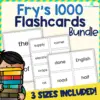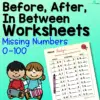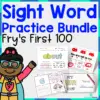Robots are intelligent machines that children find amazing. They have taken on unique appearances with varying shapes and sizes. They have inspired a myriad of shows and stories.
Encourage children to get involved in the world of robots as they explore these fantastic crafts that are engaging and stimulate creative thinking.
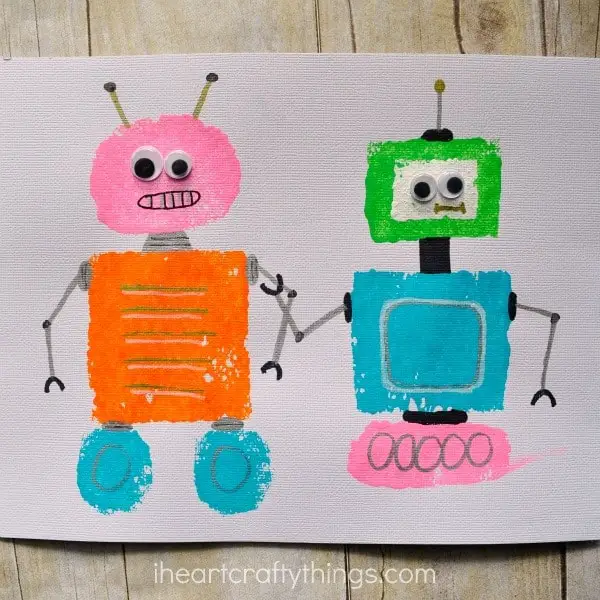
Creating artwork through a stamping technique is an exciting and simple activity that children will be interested in. The use of sponges will reinforce children’s shape-recognition skills.
Turn these into stick puppets perfect for centers. Use this robot artwork to encourage children to tell a story, focusing on the problem and solution. This step will help children to think creatively and critically.
Have the children draw shapes on the sponges and cut these out. The site recommends making the shapes in varying sizes and researching to find robot-inspired shapes for this activity.
Next, let the children squeeze some paint on the paper plate and dab the sponge in it. Ensure it is covered well with paint to make the prints visible and distinct. Have them press these on cardstock. Repeat with the other shapes;
Let the paint dry and stick the googly eyes. Use the metallic marker to add details to the robots.
For this activity, you will need:
- Sponges
- Scissors
- Cardstock
- Paper plates
- Paints
- Googly eyes
- Glue
For more information on this activity, go to IHeartCraftyThings.com.
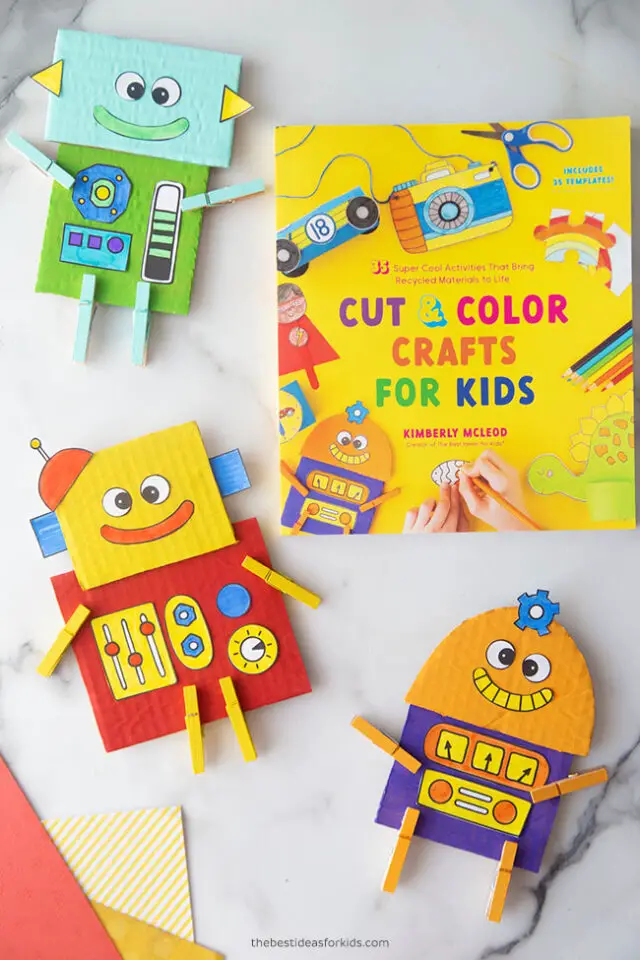
These adorable robots are made using a unique template from the book “Cut & Color Crafts For Kids” by Kimberly Mcleod. Children will have a great time completing this craft while improving their fine motor skills.
These robots are perfect for centers to use as puppets for storytelling, literacy, or math mats and as fun decorations for the room.
Peel off the template from the activity book and let the children color it with markers. Let them cut these out and set them aside.
Assist children as they cut out simple shapes from cardboard. Let them paint these. The robots should have a head and a body. Once the paint dries, have them stick the robot cutouts on the painted cardboard.
Let them clip wooden clothespins for the arms and legs.
Extend this activity by personalizing children’s robots. Let them name their robots and describe the things they can do. This will help improve their oral language skills.
For this activity, you will need:
- Printed robot template
- Scissors
- Markers
- Cardboard
- Paint
- Paintbrush
- Glue
- Clothespin
For more information on this activity, go to TheBestIdeasForKids.com.
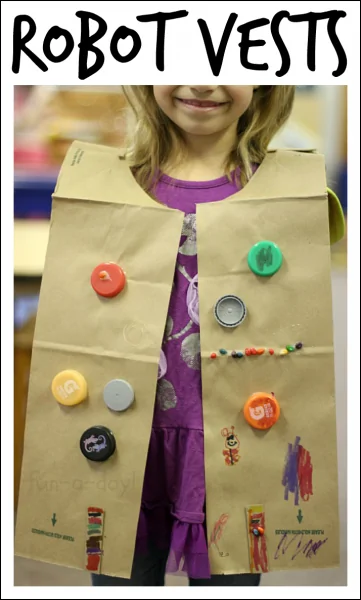
Here’s a fun way to recycle those large paper bags from the grocery store. Turn them into a robot vest that children can wear as a costume for stage plays, parties, or Halloween. This vest is also great for the pretend play area.
Encourage children to do this craft independently and use verbal instructions as a guide. This will help improve their listening skills, attention to detail, and following directions. Use clean and intact bags for this craft.
Have the children cut a straight line in the middle of the bag, two circles on each side for the arms, and a circle on the flap for the neck part. Draw lines on the bag for younger children to follow while cutting.
Let the children decorate their robot vests by gluing bottle caps and other small and lightweight materials. They can also use duct tape and draw details by using markers.
For this activity, you will need:
- Bottle caps
- Markers
- Duct tape
- Glue
- Scissors
- Paper bags
For more information on this activity, go to Fun-A-Day.com.
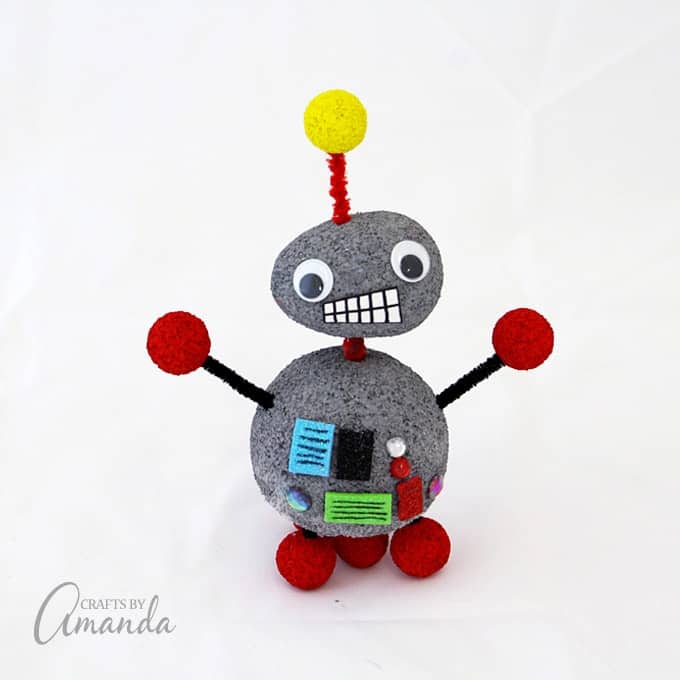
This amusing robot is made from Styrofoam balls and can be used as counters in math centers. Change the mouth shape to teach emotions or move the body parts for children to copy movements.
Have the children stick the toothpicks on each Styrofoam ball to make it easier to hold while painting. The egg shape will become the head, the large ball for the body, and the small balls for the hands, feet, and antennae.
Have the children paint the balls in the children’s preferred color and let them dry. Next, let them cut a black pipe cleaner into four. Have them bend in the middle, twist, and insert into the small balls to make the legs.
Have them do the same for the arms and let them insert the legs and arms into the body.
Let the children use a twisted red pipe cleaner for the neck and antenna. Attach the googly eyes and add stickers.
For this activity, you will need:
- Styrofoam ball and egg-shaped ball
- Paint
- Paintbrush
- Palette
- Toothpicks
- Pipe cleaners
- Craft glue
For more information on this activity, go to CraftsByAmanda.com.
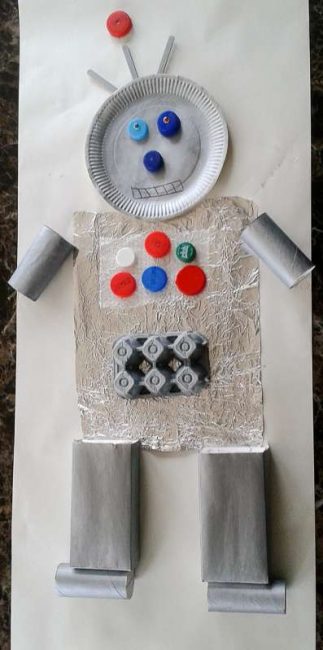
Make an environmentally-friendly junk robot from recyclable materials while providing children with fun and excitement. Teach children the concept of recycling non-biodegradable materials with this craft.
This activity will help children’s shape recognition and fine motor skills while helping them think creatively.
Let children paint the paper plate, egg carton, three craft sticks, four toilet paper rolls, and two small boxes with silver paint. Allow the paint to dry.
Next, assist the children in gluing a sheet of aluminum foil in the middle of a large butcher paper. Let them glue the small boxes for the legs and the toilet paper rolls for the hands and feet.
Have them attach the egg carton about the legs and the bubble wrap with bottle caps above it. They can glue the paper plate head with bottle caps for facial details and craft sticks for antennae. Have them use the marker to draw a mouth.
For this activity, you will need:
- Paper plate
- Craft sticks
- Toilet paper roll
- Small boxes
- Egg carton
- Bottle caps
- Aluminum foil
- Bubble wrap
- Paint
- Paintbrush
- Butcher paper
- Double-sided tape
- Marker
For more information on this activity, go to HandsOnAsWeGrow.com.
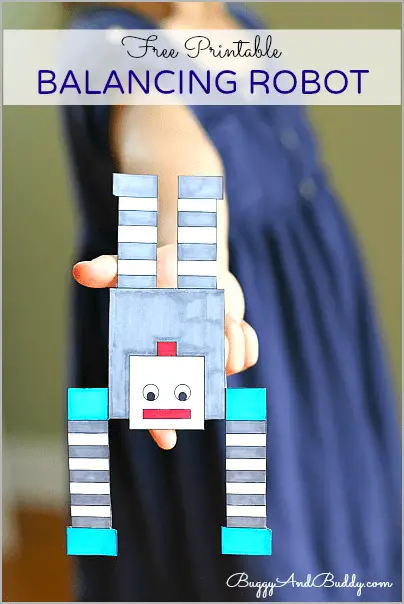
This balancing robot is a wonderful STEM craft to teach balance and stability. Children will learn to think critically as they attempt to solve the problem. This is a fantastic opportunity to discuss the concepts of weight and gravity.
The robot template can be downloaded for free from the site. Print this on white cardstock. The template contains two robots-front and back. Have the children color these using markers or crayons.
Let the children cut out the robots and provide the clay tack and pennies. Explain the challenge clearly. Ask them to make the robot stand using the given materials.
For younger children who may not figure this out, ask them to place the clay tack on both sides of the pennies and attach the robots. Let them test if their robots can balance in different places, such as flat surfaces or even their hands.
For this activity, you will need:
- Cardstock
- Two pennies
- Clay tack
- Markers or crayons
- Printed robot template
- Scissors
For more information on this activity, go to BuggyAndBuddy.com.
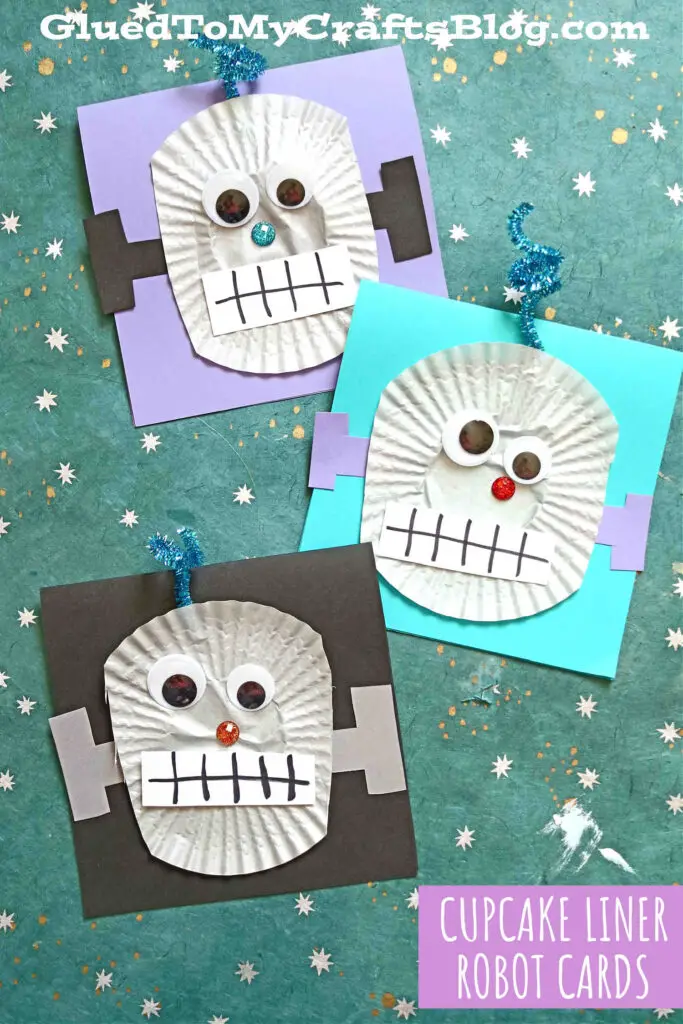
The cupcake liner robot card is a simple, easy-to-make craft that teaches creativity even to young children. Change the robot’s expression by modifying the mouth to teach children emotions.
Show children pictures of robot faces as a reference when making a customized version.
With a science lesson, discuss how robots play an important role in different sectors, such as healthcare or food services. Show videos of these, if possible.
Have the children flatten a silver cupcake liner and trim the sides to make these rectangular. Let them glue these on cardstock. Next, let them stick the googly eyes and use cardstock scraps to decorate.
Have them make a mouth from a strip of white cardstock. Let them draw lines using a black marker to make it look realistic. Let them bend, twist the pipe cleaner, and stick it on the head for the antenna. They can add embellishments as decorations.
For this activity, you will need:
- Cupcake liner
- Cardstock
- Glue
- Scissors
- Googly eyes
- Pipe cleaners
- Markers
- Embellishments
For more information on this activity, go to GluedToMyCraftsBlog.com.
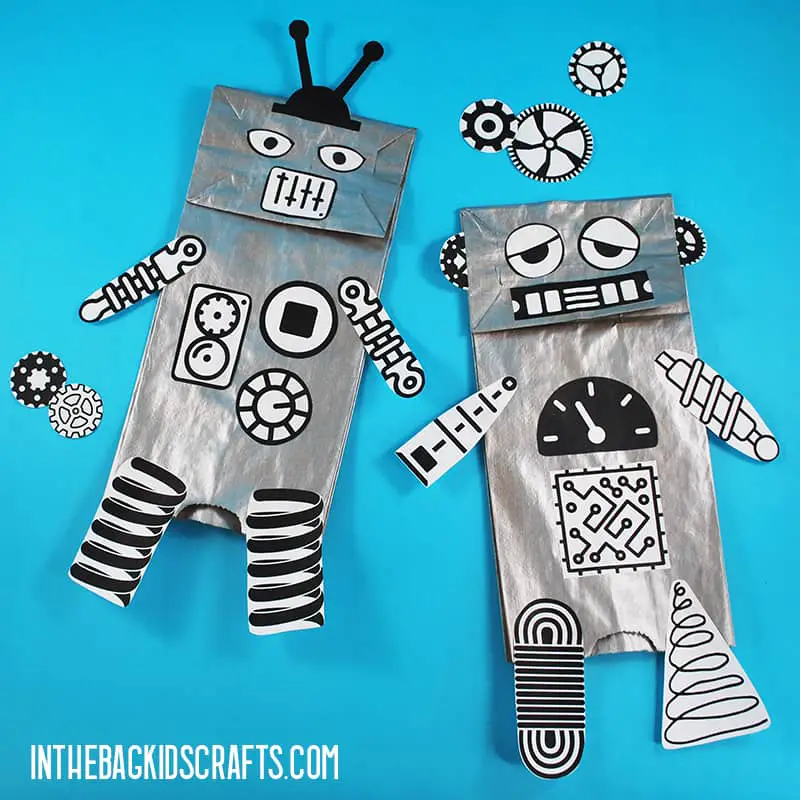
These lovable puppets are perfect for pretend play areas. Children will strengthen their hand muscles and improve their oral language skills by playing with these. Create scenarios for children that teach social-emotional learning.
Children will improve their fine motor skills as they paint, cut, and paste the pieces to complete the craft.
Lay the newspaper and have the children paint the paper lunch bags with silver color using a pompom clipped to a clothespin as an alternative to the paintbrush. Let these dry.
Download the free robot template from the site and print it on white paper. The printable comes with many different parts. Let the children cut out the pieces that they want on their robots.
Have them glue these on the paper bags to make their robots personalized.
Extend this activity by using them for storytelling or during circle time. Let the children describe their robots and explain the parts they have chosen and their functions.
For this activity, you will need:
- Paper lunch bag
- Paint
- Clothespin
- Large pompom
- Newspaper
- Glue
- Printed robot template
- White paper
For more information on this activity, go to InTheBagKidsCrafts.com.
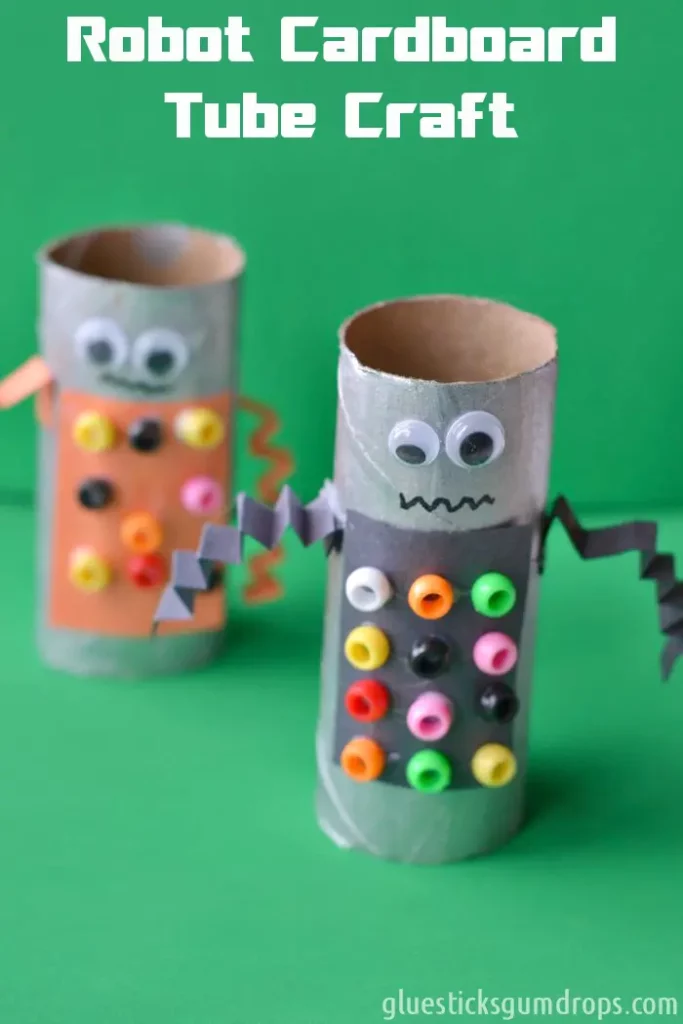
Help children build up their creativity and imagination with this craft that turns toilet paper roll into lovely robots. Using pony beads will help children with color recognition skills, and varying the number will help with their counting skills.
Completing this craft will strengthen children’s fine motor skills. Playing with these as puppets will help boost their oral language skills.
Have the children paint the toilet paper roll in a metallic silver color. While waiting for the paint to dry, let them cut out a rectangle from construction paper for the robot’s control panel and two strips for the arms.
Glue the rectangle on the toilet paper roll and add the pony beads. Next, have them glue the googly eyes while the glue dries. Let the children fold the strips of paper into an accordion style for the arms.
Glue these on each side of the control panel to complete.
For this activity, you will need:
- Toilet paper roll
- Googly eyes
- Paint
- Paintbrush
- Pony beads
- Marker
- Glue
- Construction paper
For more information on this activity, go to GlueSticksGumDrops.com.
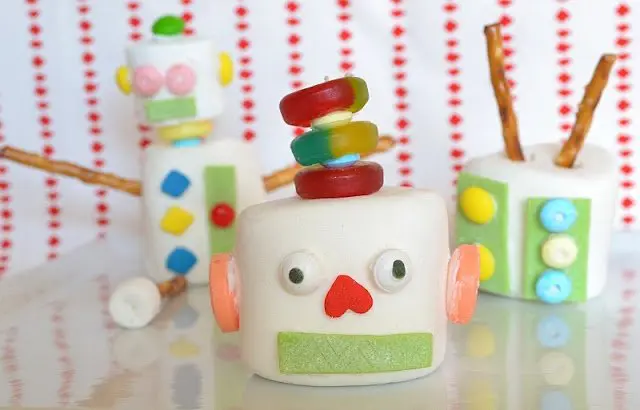
These edible works of art are literal eye candies and will provide a wonderful sensory experience for children. The robot marshmallows are great treats to make for parties or robot-themed lessons.
Let children explore their five senses with this craft. Let them name the colors, shapes, and other visual attributes. Let them describe the texture and smell of each of the candies.
These tasks will increase sensory awareness and is an excellent practice for developing oral language skills.
It is recommended to let the children make their robots by putting together different sizes of marshmallows. Show pictures of different robots for inspiration.
For example, have them use the large marshmallows as the body and the regular-sized for the head. Let them insert pretzel sticks for the arms and legs and attach mini marshmallows for the hands and feet.
They can use various candies to decorate the body and white frosting to adhere the pieces together.
For this activity, you will need:
- Marshmallows
- Pretzel sticks
- Assorted candies
- White frosting
For more information on this activity, go to RevelAndGlitter.com.
Conclusion
These robot crafts are a great way to expose children to science. This theme is ideal for encouraging children to consider a career in the robotics field through opportunities for our young scientists to develop an interest in STEM.
Thank you for reading. Come back and check out our other craft articles soon.


